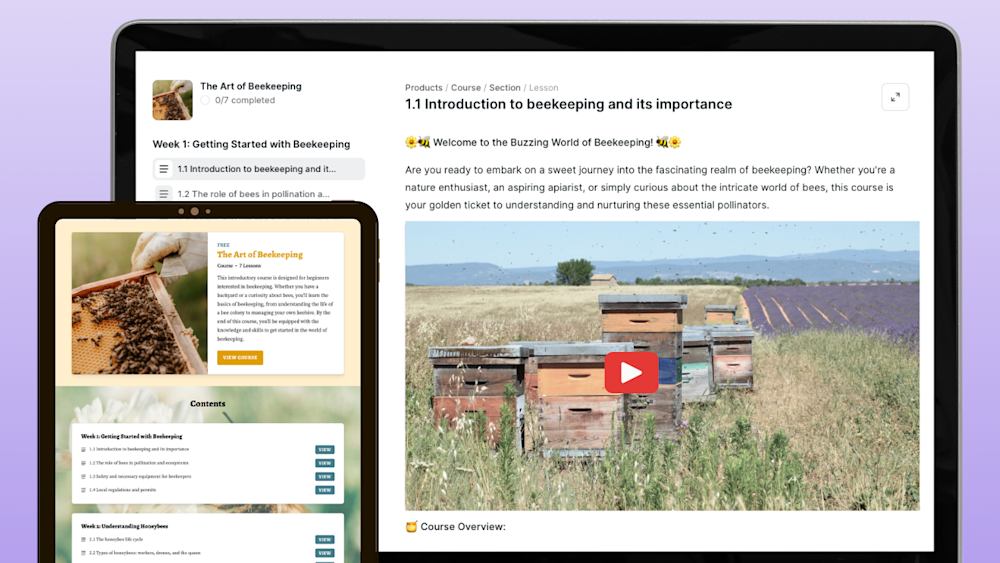You’ve been working hard at creating and selling an online course that delivers tangible results for your students.
Your website is up and running, you’ve been promoting your online course, and you’ve even sold a few courses.
But after an exciting launch, your sales start to . . . drop.
What’s going wrong? If you’re like many other course creators, you’re struggling with student engagement. Students aren’t finishing your courses, so they aren’t coming back for more, either.
In an exclusive webinar, expert online course creator and long-time educator, Reuven Lerner, shared his secrets with us for keeping students engaged throughout online courses from start to finish. Online courses may only be a part of how Reuven earns more as a developer, but they're a pivotal part, and the lessons he's learned are even more so.
Before we dive into those secrets, though, let’s take a look at the motivation behind keeping students engaged.
Why engagement is the only thing that matters for online course students
When it comes to selling online courses that aren’t engaging -- which happens a lot -- the results are “bad for everyone,” according to Reuven.
“It’s bad for the learners because they’re not getting the benefits of our course,” he explains.
“It’s bad for us as teachers because students aren’t learning from us. Presumably, we’re not just teaching because we want to make lots of money. We’re teaching because we want people to benefit from our experience and our knowledge.”
Which is exactly why Reuven dedicates so much of his effort toward creating engaging online courses for his students. It’s not strictly a scholastic dividend, either: highly-engaged students benefit from the learnings of online courses, so they come back for more.
In other words, it’s a win-win.
“People who finish your course get really jazzed about it. They really like what you did, and they're probably going to come back for more,” Reuven reassures.
Conversely, if your students aren’t engaged, they’re prone to simply purchasing your online course and forgetting about it, which benefits neither your students nor your business.
But if the connection between engagement and business growth seems so easy, why does it require any secrets, let alone seven of them?
Because, as simple as it sounds, creating engaging content comes with its set of challenges. 65% of people find it difficult to produce engaging content.
Fortunately, Reuven’s first secret helps clear things up on that front: If you want to make creating engaging courses simple, keep things on the slim side.
Secret #1. Keep your courses short and focused
Reuven’s first tip is to break up your course content length into smaller, more digestible chunks and keep it short and focused.
As an educator, this may feel counterintuitive because you likely want to instill as much knowledge as possible, but that isn’t necessary or even desired by your students.
Reuven advises, “Keep the list of subjects you're going to teach short because they aren’t going to be able to learn as much as you want. You want to teach them everything.”
Another benefit of keeping your course modules short and focused is that the price point comes down.
“More people will buy because it won't be at that really expensive price point.” Reuven explains, “and then they'll come back because they'll finish it more quickly. They'll feel like, ‘Oh, that wasn't too much money…’ and they'll buy your other courses.”
One of the ways Reuven shortens his course content is by cutting up his video tutorials.
“So here and there, I have some videos. They're like 10-12 minutes long, but most are about 4-6 minutes long,” he divulges. “And if there's a topic that I can slice into additional pieces, I totally do that.”
Alternatively, instead of reducing your video length alone, you can also set constraints on the duration of the course. This can be especially beneficial for topics that are too advanced for students to reasonably learn on their own in a handful of weeks, such as Python.
Reuven employs this strategy with online courses that run in weekly segments, such as his upcoming Weekly Python Exercise.
The key to making interval-based courses work is, as you’ve probably guessed by now, keeping them engaging with interactive elements, such as live office hours and coaching. So if you’re keen to teach something complex, don’t just stop at keeping the content short and sweet.
Make the delivery the same, too.
In sum:
You don’t need to teach your students everything you know. Just focus on delivering an outcome and keep your online course brief and focused. This will keep your students more engaged.
So will Reuven’s next secret.
Secret #2. Learn and iterate
Reuven’s second tip is to continue to iterate your online course by trying different ways of explaining things to find out what sticks and resonates with your students. Then, incorporate what you learn into your course.
“Try to explain things in different ways, try to use different metaphors, analogies, and charts,” he guides. “And when you see that something works… you know it's more likely to hold people's attention.”
It’s the same strategy standup comedians use in their nightly sets.
“They look at the audience, and they're seeing what works and what doesn't,” Reuven elaborates. “And they're constantly cutting and . . . constantly trying and re-trying . . . and changing things around based on the feedback that they get.”
You don’t have to have a finished product to start gathering that feedback, by the way. You can start generating sales and gleaning insights from your audience with an incomplete product offered at a lower price point.
That’s what Reuven does, as you can see in his also-upcoming online course on Pandas.
Beyond the obvious monetary advantage of allowing Reuven to start reaching customers before the course is finished, releasing an early version of his products also enables him to validate and iterate in real-time.
And since iteration is a constant process, the sooner you can get started, the more worthwhile your results will be. “After you've got it really done and polished, then it's going to be really engaging for the people who are watching your videos,” says Reuven.
Basically, treat your online course as the malleable material it is and be not just open, but responsive to feedback your customers provide.
Secret #3. Teach with a live element
Reuven’s third secret is to include a live portion in your course. While Reuven’s particular teaching strategy of using live coding won’t work for all online course topics, a live element is a must-have to include in your course material.
Why?
It forces people to engage with your content instead of simply reading slides.
This is important because slides give people the option to watch your course later and procrastinate.
And procrastination is a pervasive problem. We’re procrastinating more than before at quadruple the rate compared to 30 years ago.
What’s worse is an alarming 85-95% of students procrastinate, and 40% of people bear a financial loss because of it -- yikes.
So anything you can do to curb that procrastination for your students, the better.
Reuven’s advice for avoiding such procrastination is to find a way to “allow your students to see the process . . . people constantly respond to my courses in person, saying the live coding was way, way better than just seeing slides.”
Regardless of your course topic, find ways to explain why you’re doing something as you demonstrate your process.
In Reuven’s case, live coding means his students have to follow along his process, which is, “start, make a mistake, think about it, and change it a little bit.” When they follow along his process, his students learn from it and are more likely to adopt it.
The gist of it is:
Add a live element to your online course that demonstrates one of your key processes. This will boost your students’ involvement and the way they absorb your course content.
Secret #4. Bring your energy, zest, and sense of fun
Another one of Reuven’s secrets is to have fun, present with energy, and tell personal stories while teaching.
“If you're not having fun, they're definitely not going to have fun,” Reuven warns.
“If you're not enjoying yourself, it's going to be really obvious, and your students are only getting a small fraction of that. So the more energy you can throw into it, the better.”
Wondering how Reuven brings his zest and sense of enjoyment to his online courses?
One way is through jokes.
“I make tons of jokes in my courses, more in person than recorded,” he reveals. “Believe me, there are times that I'll make a joke in my recorded class, and I will laugh out loud in the goofy way that makes my entire family embarrassed. That's OK.”
Other ways you can engage your audience through your energy level are:
-
Tell stories
-
Use metaphors
-
Share personal experiences
Each of these methods uses storytelling, which is a very powerful tool to help people retain information better.
In fact, messages delivered as stories are 22x more memorable than explaining just facts.
In a nutshell:
Enjoy yourself, be enthusiastic, and share your personal experiences through storytelling.
This will encourage student engagement and interactions, which brings us to our Reuven’s next secret.
Secret #5. Prioritize interactions
Another engagement secret is to focus on creating interactions throughout your online course.
Reuven is a big fan of interactions and believes they’re the foundation of learning.
“So I'm convinced through everything I've done personally in education, teaching, and my academic studies, learning is all about interactions.”
When it comes to his online courses, he focuses on two types of interactions:
#1. Teacher-to-student interactions
Just as it sounds, this is when students engage with the instructor. It’s another avenue for asking questions and learning from you as the teacher.
“I strongly suggest you try doing office hours once a month or so, or even once in a while. See how it works,” Reuven urges.
#2. Student-to-student interactions
Student-to-student interactions focus on building relationships among student peers. Reuven believes there are three main benefits of student-to-student interaction:
-
Your students learn from each other and learn by teaching. When you explain something to someone, you’re forced to think through it and find the gaps in your understanding.
-
It puts less pressure on you as the instructor to cover everything.
-
It adds a level of variety to the emails and videos that you send out. There’s a camaraderie among people going through the same thing at the same time.
Wondering how Reuven implements student-to-student interactions?
He uses Discourse to set up exclusive student-only online forums. “I love Discourse. It's private to the people who've registered for my course. People share,” he explains. “So on Tuesdays, the questions come out, and people start to exchange ideas.”
On the platform, his students ask each other how they solve problems, explain their methods, and learn from one another using the online platform.
Doesn’t get more engaging than that.
Note that while other options include Facebook groups and Slack channels, Reuven prefers using Discourse for engaging his online student communities because it provides a more focused and less distracting space.
To recap:
Find ways to encourage both student-to-teacher and student-to-student interactions. Set regular office hours and use tools, such as Discourse, to create a space where students develop relationships and learn from both you and other students.
Ready for another method of engaging your students? Great, read on.
Secret #6. Incorporate exercises
Another one of Reuven’s tips is to include exercises as part of your course content, which also “keeps people going and engaged and learning . . . making their investment worthwhile.”
After all, can you think of anything you learned well that you didn’t have to practice (probably a lot)?
“I'm surprised that more people don't do this because it's easy to do,” he comments. “You record one video, where you say, ‘OK, now I want you to practice this.’"
Then you record two more follow-up videos.
In Reuven’s second exercise video, he walks his students through how to solve the exercise, and in the final video, he goes through and solves the exercise with them.
The reason why this works for keeping his students working through the course is a simple cause-and-effect relationship.
“You can only do the exercises if you watch the video,” he explains.
“This keeps people engaged, it keeps them going, it keeps them wanting to go through the course,” Reuven adds, saying that students are simultaneously proving to themselves they’re learning something and that their investment in the course was worthwhile.
The heart of it is this:
When planning and producing your course content, be sure to include an interactive component, such as exercises, where your students can learn from a process that’s broken down for them as well as practice the process along with you.
OK, now for Reuven’s last secret today.
Secret #7. Poll your students
Reuven’s final secret for us is to ask your students questions and receive feedback from them so you can continue to improve your online course.
He’s not alone in his thought process, either. 52% of customers believe companies need to take action on feedback provided by their customers, which means they expect their input to shape the way companies conduct business.
In other words, feedback is critical in improving a company’s product or service, and your online course is no different.
What’s Reuven’s preferred method of polling his students?
He uses Drip to send out emails requesting feedback. “I use Drip, and I have an automated hook that sends 30 days after someone buys my course.” In his email, he asks for feedback like:
-
What did you like?
-
What did you not like?
-
How can I improve things? Tell me about it.
Which results in students giving him inspirations and ideas. Reuven then uses the gathered info to either improve the course in question or create an even better product with a new course.
(Want to link up your online course platform with Drip? Podia integrates seamlessly with Drip, and many other email marketing suites, and you can get started for free today.)
Another way to gather feedback from your students is to, of course, talk to your customers. Reuven shares: “The people who say, ‘hey, I'd like to talk to you about this,’ are going to give you great feedback. Listen to them. They want to succeed.”
The bottom line here is to include a feedback survey in your email marketing, so you can gather valuable data to improve your online course.
Keep your customers coming back for more
It’s vital to engage your students so they finish your course, achieve their desired results, become a raving fan, and come back for more.
Unfortunately, most people miss the mark for engaging online course customers.
To prevent you from doing the same, let’s recap Reuven’s secrets:
-
To create an engaging online course, don’t teach your students everything you know. Instead, keep it short, focused, and results driven.
-
Treat your course as a living project and constantly iterate your material to better meet your students’ needs. Also, constantly ask for feedback so you can work in requests and improvements into your iterations.
-
Include a live element in your course, such as live coding or breaking down a process, to further engage your students. Incorporate exercises and have your students practice the process as another way to keep them engaged.
-
Have fun and bring enthusiasm to your lessons.
-
Set office hours and create an online community to encourage interactions with and amongst your students.
Now that you’re equipped with these proven tactics for creating an engaging online course, you can work on improving your student experience.
It’s worth the effort for both your students and your business, no?



